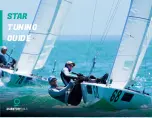
1-12
210 Montauk
Section 1• Safety
R
Other recognized visual distress signals include:
• Flames in a bucket
• Code flags November & Charlie displayed
together.
• Black square & ball on orange background
flag
• Orange flag (certified)
• Electric distress light (certified)-for night use
• Dye marker (any color)
• Person waving arms (slowly)
• U.S. ensign flown upside down
a
udibLe
d
istress
s
ignaLs
, (ads)
U.S. Coast Guard regulations require one hand,
mouth or power operated whistle or horn, audible
for at least 1/2 mile.
Other recognized audible distress signals include:
• Radio communication (see
Radio
Communication
below)
• Radio-telegraph/telephone alarm
• Position indicating radio beacon (EPIRB)
• Morse Code S-O-S (3 short 3 long 3 short)
sounded by any means.
• Fog horn sounded continuously.
Radio Communication
A radio is the boat operator’s main method of
receiving safety information and summoning aid.
VHF-FM radio is the primary means of short range
communication. Single sideband radio (SSB) is used
for longer range communication.
VHF-FM channel 16 and SSB 2182 kHz are
designated for emergency use. Such situations can
be categorized as:
•
EMERGENCY
-
“MAYDAY, MAYDAY, MAYDAY,”
- used
when life or vessel is in imminent danger.
•
URGENCY
-
“PAN-PAN, PAN-PAN, PAN-PAN”
(pronounced PAHN-PAHN)-used when
a person or vessel is in some jeopardy less
than indicated by a “MAYDAY” call.
•
SAFETY
-
“SECURITY, SECURITY, SECURITY”
(pronounced SAY-CURE-IT-AY)-used for
navigational safety or weather warning.
An emergency situation will be hectic and there will
not be time to learn proper radio procedure.
LEARN
WHAT TO DO BEFORE YOU NEED TO DO IT.
If you hear a distress call, stop all radio transmissions.
If you can directly assist, respond on the emergency
frequency. If you cannot assist, do not transmit on
that frequency. However, continue to monitor until
it is obvious that help is being provided.
Weather
Getting caught in severe weather is hazardous. Bad
weather and/or rough sea or water conditions can
cause an unsafe situation. Consult local weather
services for up-to-date forecasts on weather and sea
conditions. Television, Radio, Internet can give you
access to NOAA weather reports that will help you
make a determination on where and when to get
underway.
Following are some weather related rules:
• Understand the design limitations of your boat.
• Check the weather forecast and water
conditions before leaving and while underway.
• Wear a Personal Flotation Device, (PFD).
DO NOT attempt to boat in severe weather
conditions. Death or serious injury can occur.
Get to shore before the weather turns bad.
!
DANGER
Summary of Contents for 210 Montauk
Page 1: ...210 Montauk Owner s Manual ...
Page 43: ...1 22 210 Montauk Section 1 Safety R THIS PAGE INTENTIONALLY LEFT BLANK ...
Page 94: ...4 7 210 Montauk Section 4 Electrical System R 12 VDC Wiring Diagram Sheet 1 Fig 4 7 1 ...
Page 95: ...4 8 210 Montauk Section 4 Electrical System R 12 VDC Wiring Diagram Sheet 2 Fig 4 8 1 ...
Page 98: ...4 11 210 Montauk Section 4 Electrical System R T Top Harness Fig 4 11 1 ...
Page 99: ...4 12 210 Montauk Section 4 Electrical System R THIS PAGE INTENTIONALLY LEFT BLANK ...
Page 111: ...5 12 Section 5 Care Maintenance R 210 Montauk Reinforcement Location Diagram ...
Page 113: ...5 14 Section 5 Care Maintenance R 210 Montauk THIS PAGE INTENTIONALLY LEFT BLANK ...
















































